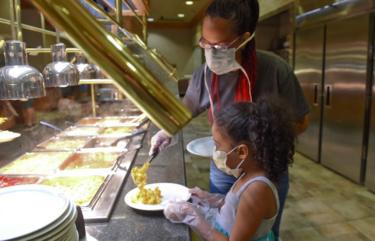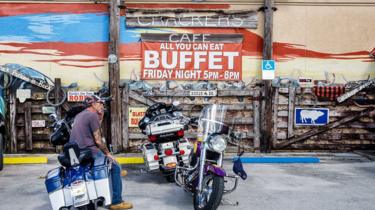Yes, referring to June employment figures. I am more wondering about the aggressive strategy that is beating back the virus. It is the first I have heard of a strategy on a Federal level. I guess, if there is a strategy, it hasn't been so successful in July.
Re: The buffets. I can't imagine ever eating a restaurant buffet again. I got food poisoning from a buffet several years ago ... that put me off forever. Especially out of the question in this time of covid.
I think the strategy is mentioned in this briefing.
Remarks at White House Coronavirus Task Force Briefing
Excerpt from the briefing.
We've built up our readiness under the strategy we developed to address surges, save lives, and, in time, defeat the virus. We're in a much stronger position to support states, hospitals, and individuals as they fight back.
There are six parts to the strategy: surveillance, testing, containment, healthcare capacity, therapeutics, and vaccines.
First, we've been strengthening surveillance so that we can be aware of and respond to surges. That means, for instance, being able to track more cases among younger Americans that we never would have caught earlier in the pandemic.
Second, we have the world's greatest testing capabilities, enabling us to confirm the presence of the virus when it crops up, and we are confident that capacity will continue to rise in the coming months.
Third, states are building the capacity to track and contain outbreaks of the virus. With federal help, many states have substantially expanded their own capabilities, and we're deploying knowledgeable, experienced CDC teams to the areas now seeing increases.
Fourth, we're helping healthcare systems secure sufficient capacity and supplies. We've dramatically expanded American manufacturing of PPE, and the FDA has authorized new technologies to sterilize equipment for reuse. We've spoken with hospitals and states that are building up their own PPE reserves, many of them getting up to 60 or 90 days of supplies. Through the Strategic National Stockpile, we have far more visibility into supply needs across the country, including centralized coordination capabilities that we lacked just a few short months ago.
Visiting healthcare providers around the country, I've seen how they're adapting to bring back patients while taking appropriate precautions. America's hospitals are ready to get back to business, while maintaining their readiness for COVID-19.
The fifth and sixth elements of this strategy are thanks to the President's historic Operation Warp Speed.
We now have promising therapeutics that are benefiting tens of thousands of American patients and, in all likelihood, have saved thousands of lives already. We've identified two very promising pharmaceutical treatments, remdesivir and dexamethasone. As of today, we've allocated more than 120,000 courses of remdesivir to all of the 50 states. We've added dexamethasone, a very low-cost steroid, to our treatment guidelines, and we believe it is reasonable to assume that other corticosteroids, which may be more readily accessible in some places, would have similar immunologic effects. Another promising therapeutic, convalescent plasma, has been used to treat more than 25,000 Americans in nearly 3,000 sites across the country.
There are no certainties in science, but with more than 140 clinical trials underway in the U.S., it's a pretty safe bet that more good news on therapeutics is on the way, and on the way soon.
Finally, we have announced large investments to support three different vaccine candidates all the way through to manufacturing. These candidates are now in human clinical trials, some with the potential to start delivering safe and effective doses before the end of the year, and we'll be adding support for several more candidates. We're expanding manufacturing capacity and already making the vials, needles, and syringes that we may need.
Our capabilities have grown exponentially in the time allowed by the patriotic sacrifices of the American people. We have a much better grasp of the virus and much more data with which to model it.
With that data, as you've heard today, we can focus on local trends. We have some very concerning hotspots, and we can track when other hotspots emerge, as we expect they may. We're focused on the states and the counties within those states—approximately 3 percent of counties—that represent hotspots.
It's important for the American people to be aware of this variation across the country.
Americans need to understand their local trends because we want to help people make the right decisions for themselves.
Making decisions for yourself has to be based on three axes of risk: You want to assess where you are, who you are and whom you live with, and what activity you're thinking about doing.
There are gradations of risk within each of these axes.
Going to an outdoor restaurant in Montana is a great deal different from a crowded indoor bar in Houston. When you interact with fewer people in an activity, when you interact with them for a shorter time, your risk is reduced, and individuals can balance these kinds of factors.
What I've laid out today is remarkable progress by the President's administration, and a particular credit to our team here at HHS.
Continued at link.




